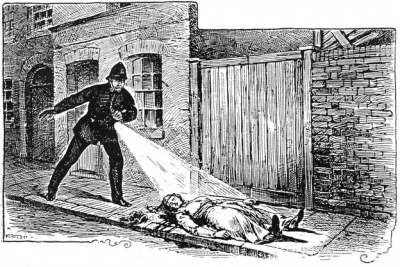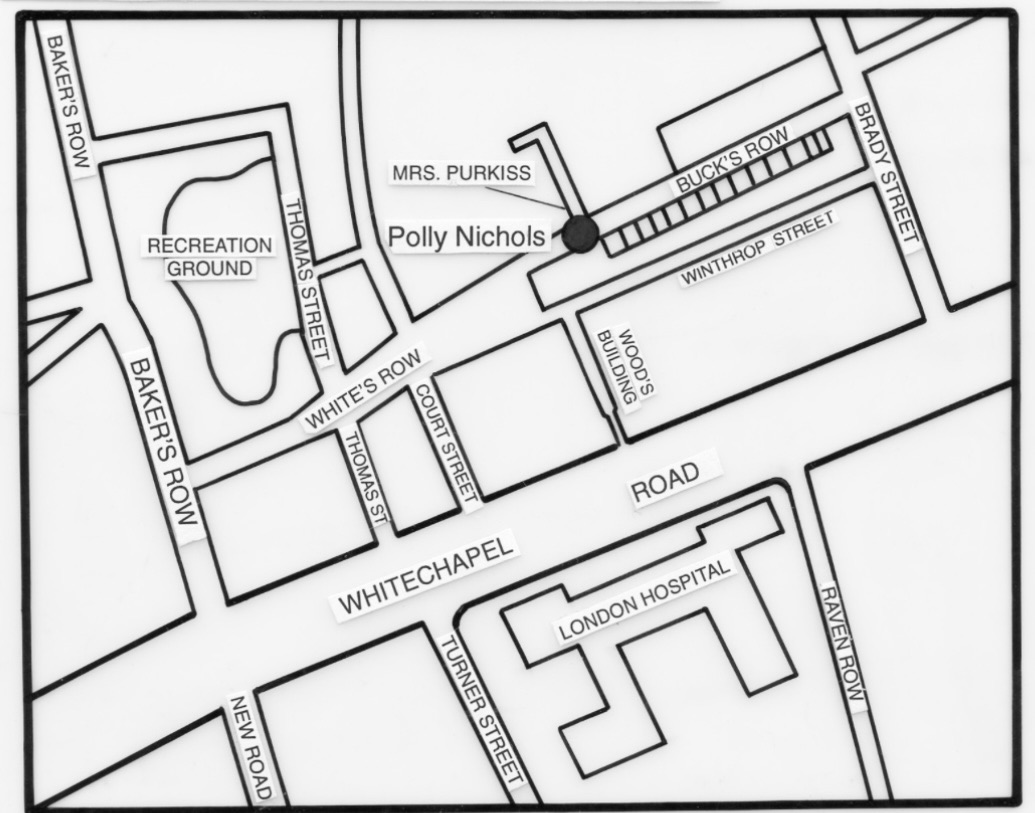Wilmott’s Lodging House at 18 Thrawl Street, Spitalfields. There she shares a room with four women including Emily Holland. The room is described as being surprisingly neat. The price of the room is 4d per night.
On 8/24/88 Polly moves to a lodging house known as the White House at 56 Flower and Dean Street. In this doss-house men are allowed to share a bed with a woman.
Thursday, August 30 through Friday, August 31, 1888.
Heavy rains have ushered out one of the coldest and wettest summers on record. On the night of August 30, the rain was sharp and frequent and was accompanied by peals of thunder and flashes of lightning. the sky on that night was turned red by the occasion of two dock fires.
11:00 PM — Polly is seen walking down Whitechapel Road, she is probably soliciting trade.
12:30 AM — She is seen leaving the Frying Pan Public House at the corner of Brick Lane and Thrawl Street. She returns to the lodging house at 18 Thrawl Street.
1:20 or 1:40 AM — She is told by the deputy to leave the kitchen of the lodging house because she could not produce her doss money. Polly, on leaving, asks him to save a bed for her. ” Never Mind!” She says, ”I’ll soon get my doss money. See what a jolly bonnet I’ve got now.” She indicates a little black bonnet which no one had seen before.
2:30 AM — She meets Emily Holland, who was returning from watching the Shadwell Dry Dock fire, outside of a grocer’s shop on the corner of Whitechapel Road and Osborn Street. Polly had come down Osborn Street. Holland describes her as ”very drunk and staggered against the wall.” Holland calls attention to the church clock striking 2:30. Polly tells Emily that she had had her doss money three times that day and had drunk it away. She says she will return to Flower and Dean Street where she could share a bed with a man after one more attempt to find trade. ”I’ve had my doss money three times today and spent it.” She says, ”It won’t be long before I’m back.” The two women talk for seven or eight minutes. Polly leaves walking east down Whitechapel Road.

PC Neil discovers Nichols’ body in Buck’s Row, from Famous Crimes Past and Present, 1903.
At the time, the services of a destitute prostitute like Polly Nichols could be had for 2 or 3 pence or a stale loaf of bread. 3 pence was the going rate as that was the price of a large glass of gin.
3:15 AM — PC John Thain, 96J, passes down Buck’s Row on his beat. He sees nothing unusual. At approximately the same time Sgt. Kerby passes down Buck’s Row and reports the same.
3:40 or 3:45 AM — Polly Nichols’ body is discovered in Buck’s Row by Charles Cross, a carman, on his way to work at Pickfords in the City Road., and Robert Paul who joins him at his request. ”Come and look over here, there’s a woman.” Cross calls to Paul. Cross believes she is dead. Her hands and face are cold but the arms above the elbow and legs are still warm. Paul believes he feels a faint heartbeat. ”I think she’s breathing,” he says ”but it is little if she is.”
The two men agree that they do not want to be late for work and after arranging Nichols’ skirts to give her some decency, decide to alert the first police officer they meet on their way. They eventually meet PC Jonas Mizen at the junction of Hanbury Street and Baker’s Row and tell him of their find.
In the meantime, Nichols’ body has been found by PC John Neil, 97J. He signals to PC Thain who then joins him and the two are soon joined by Mizen. Thain calls for Dr. Rees Ralph Llewellyn, who resides nearby. The two return a few minutes later (around 3:50 A.M.) and Dr. Llewellyn pronounces life to have been extinct ”but a few minutes.”
Buck’s Row is ten minutes walk from Osborn Street. The only illumination is from a single gas lamp at the far end of the street.
Polly’s body is found across from Essex Wharf and the Brown and Eagle Wool Warehouse and Schneiders Cap Factory in a gateway entrance to Brown’s stableyard between a board school (to the west) and terrace houses (cottages) belonging to better class tradesmen. She is almost underneath the window of Mrs. Emma Green, a light sleeper, who lives in the first house next to the stable gates. Her house is called the ’New Cottage’. She is a widower with two sons and a daughter living with her. That night, one son goes to bed at 9:00 PM, the other follows at 9:45. Mrs. Green and her daughter shared a first floor room at the front of the house. They went to bed at approximately 11:00 PM. She claims she slept undisturbed by any unusual sound until she was awakened by the police.
Opposite New Cottage lives Walter Purkiss, the manager of Essex Wharf with his wife, children and a servant. He and his wife went to bed at 11:00 and 11:15 respectively. Both claimed to have been awake at various times in the night and heard nothing.
Polly Nichols’ body is identified by Lambeth Workhouse inmate Mary Ann Monk and the identification confirmed by William Nichols.
An inventory of her clothes is taken by Inspector John Spratling at the mortuary. She was wearing: (overall impression — shabby and stained)
- Black Straw bonnet trimmed with black velvet
- Reddish brown ulster with seven large brass buttons bearing the pattern of a woman on horseback accompanied by a man.
- Brown linsey frock (apparently new according to Sugden. Could this be a dress she stole from the Cowdrys?)
- White flannel chest cloth
- Black ribbed wool stockings
- Two petticoats, one gray wool, one flannel. Both stenciled on bands ”Lambeth Workhouse”
- Brown stays (short)
- Flannel drawers
- Men’s elastic (spring) sided boots with the uppers cut and steel tips on the heels
Possessions:
- Comb
- White pocket handkerchief
- Broken piece of mirror (a prized possession in a lodging house)
Observations of Dr. Rees Ralph Llewellyn upon arrival at Bucks row at 4:00 AM on the morning of August 31st. After only a brief examination of the body he pronounced Polly Nichols dead. He noted that there was a wine glass and a half of blood in the gutter at her side but claimed that he had no doubt that she had been killed where she lay.
Inquest testimony as reported in The Times:
”Five teeth were missing, and there was a slight laceration of the tongue. There was a bruise running along the lower part of the jaw on the right side of the face. That might have been caused by a blow from a fist or pressure from a thumb. There was a circular bruise on the left side of the face which also might have been inflicted by the pressure of the fingers. On the left side of the neck, about 1 in. below the jaw, there was an incision about 4 in. in length, and ran from a point immediately below the ear. On the same side, but an inch below, and commencing about 1 in. in front of it, was a circular incision, which terminated at a point about 3 in. below the right jaw. That incision completely severed all the tissues down to the vertebrae. The large vessels of the neck on both sides were severed. The incision was about 8 in. in length. the cuts must have been caused by a long-bladed knife, moderately sharp, and used with great violence. No blood was found on the breast, either of the body or the clothes. There were no injuries about the body until just about the lower part of the abdomen. Two or three inches from the left side was a wound running in a jagged manner. The wound was a very deep one, and the tissues were cut through. There were several incisions running across the abdomen. There were three or four similar cuts running downwards, on the right side, all of which had been caused by a knife which had been used violently and downwards. the injuries were form left to right and might have been done by a left handed person. All the injuries had been caused by the same instrument.”
Inspector Joseph Helson, J-division, is notified of the murder at 6.45am and at the mortuary he is shown the body and the extent of the mutilations.
With all of her faults Nichols seems to have been well-liked by all who knew her. At the inquest her father says, ”I don’t think she had any enemies, she was too good for that.”





